How to Get Rid of Black Hair Algae
Let's face it:
Beards look better on your face than they do in your aquarium!
In an aquarium, it just looks like a fuzzy mess.
I'm talking about black beard algae. The bearded monster that can quickly take over your tank.
Today, I am going to show you how to identify it, get rid of it, and stop it from coming back!
What is black beard algae and how to identify it?

I love it when things are named after what they look like, and black beard algae is certainly that – a black algae that looks like a scruffy beard. It is also referred to by the name black brush algae or by the initials BBA.
While black beard algae is considered to be a saltwater algae, there are strains that are common to freshwater tanks. In fact, in all my years of fishkeeping, I have probably seen more freshwater tanks become plagued by this bearded menace than saltwater ones.
It may surprise you to learn that despite its name and look, black beard algae is actually a member of the red algae family. This shouldn't surprise any of you who have killed black beard algae before – it turns a red color as it dies.
However, when it is healthy, black beard algae's color ranges from a dark green, browny gray to a deep black. While its color may vary, one thing remains constant – its look.</p
Just like a beard, this algae starts out as light stubble – small spots of fuzz that cling to the surface of anything in your aquarium.
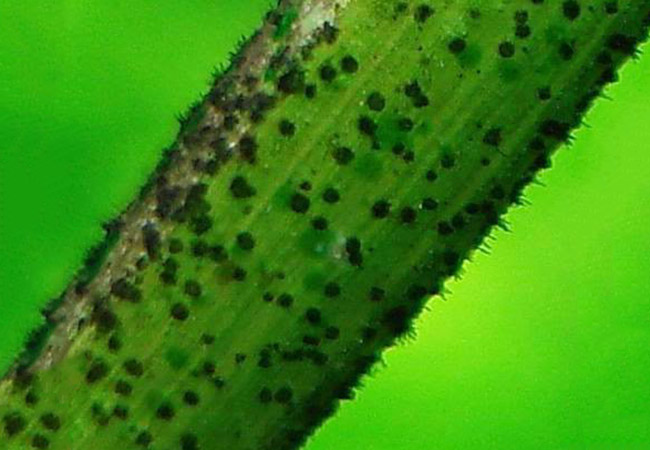
As time passes, the black beard algae looks more like three-day growth…
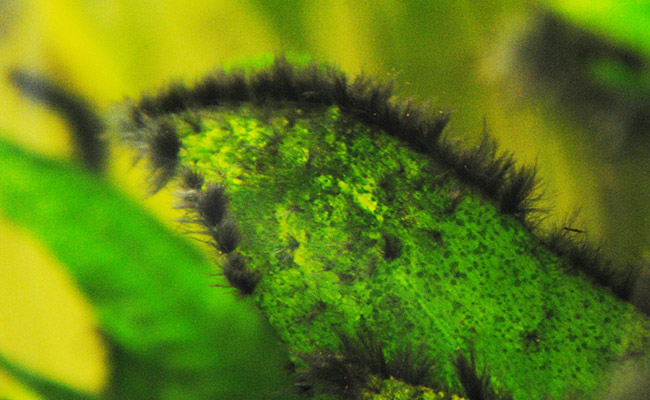
But if left unattended, it soon grows into a glorious, thick and brushy, hair jungle.

Seriously, it looks like hair straight out of a shampoo commercial!
Like most algae, black beard algae draws its nutrients from the water. This allows it to grow on virtually any surface in your aquarium including…
Driftwood…
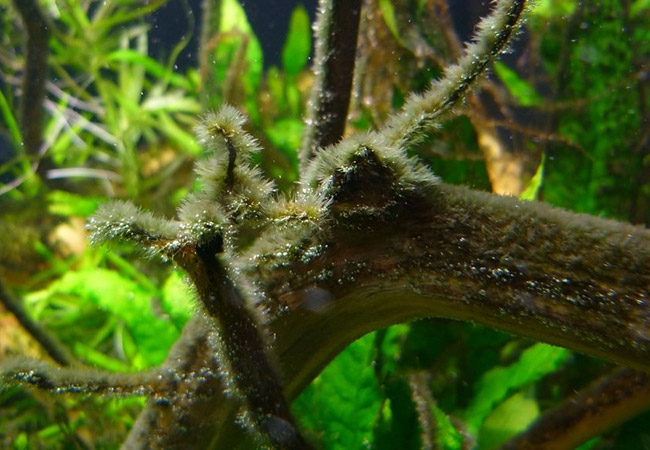
Filter pipes and airline tubing…
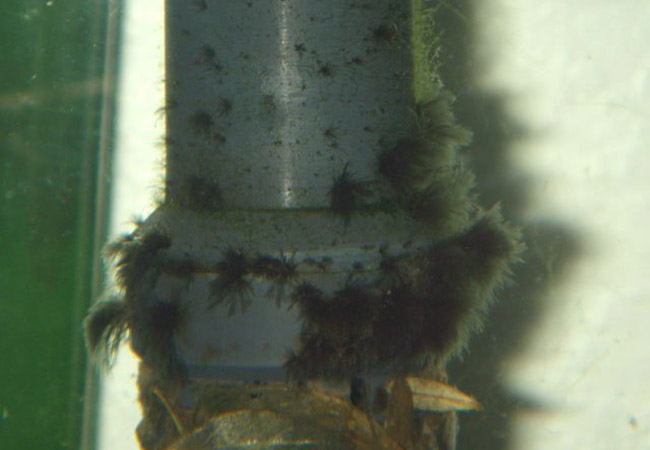
On the surface of your substrate…
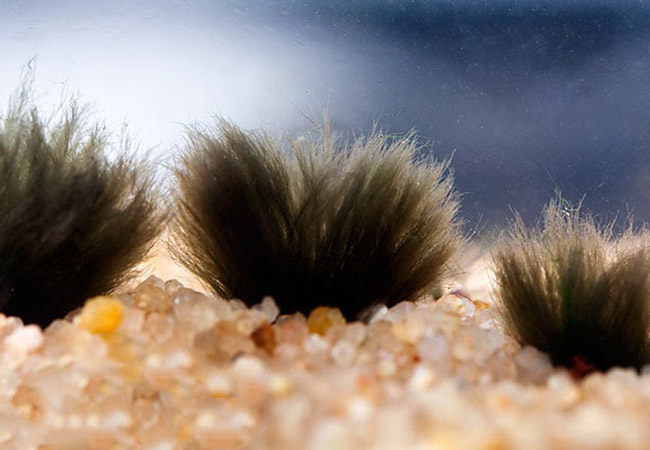
Even on the shell of your snail!
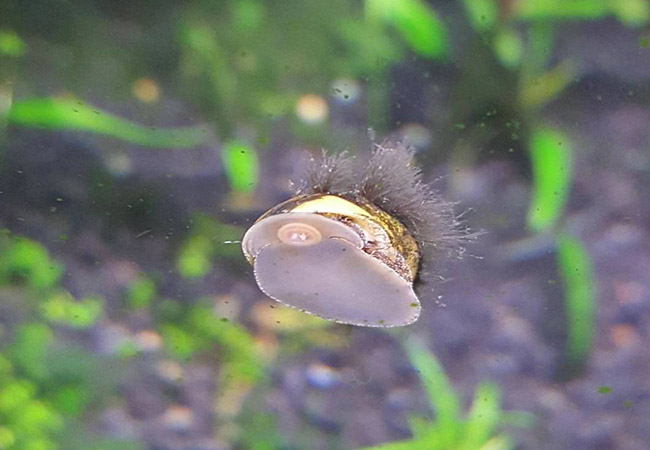
My point is that black beard algae can grow anywhere. Decorations, rocks, even on the glass of your fish tank!
Black beard algae is easiest to spot when it grows on plants. It typically grows on the edges of the leaves before expanding and covering them completely.
Don't be confused with…
Black beard algae is often confused with staghorn algae. And, I can see why – fully grown staghorn algae looks much more like a wiry beard than black beard algae does.
So, how do you tell the difference?
Let's compare the two during their early stages of growth…
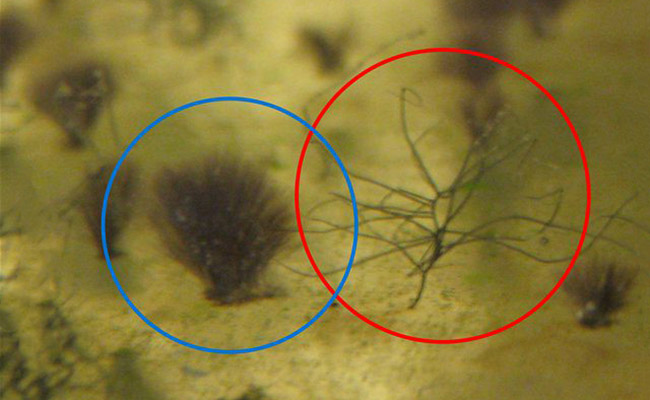
In the blue circle, you have black beard algae, resembling the tightly packed clusters of bristles you find on a makeup brush. Staghorn algae, circled in red, looks more like the antlers of a male deer – hence the name.
When fully grown, the two also look quite different, but unless you compare them side by side, it's easy to see where the confusion comes from.
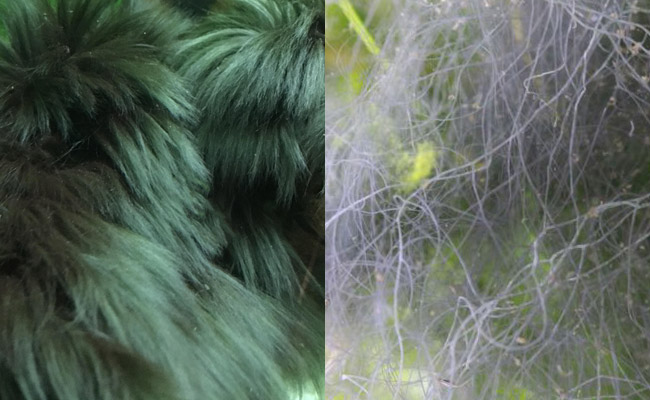
Fully grown black beard algae, on the left, is dense and bushy while staghorn algae, on the right, is sparse and wiry.
For more information and pictures (and how to beat it), check out our in-depth staghorn algae guide.
Is black beard algae harmful to fish?

Nope, black algae is not dangerous to your fish.
In fact, if you let your black hair algae grow, many fish happily swim and hide in the long flowing hairs.
Plants on the other hand…
Is black beard algae harmful to plants?
Yes… But not directly.
Let's say that you notice black beard algae beginning to grow on the edges of one of your plants. No harm done.
The problem is… As the algae begins to spread, it blocks out more and more light.
And if you know about photosynthesis, you are fully aware that light is vital for most aquarium plants to survive. Without it, they die.
So yes, an uncontrolled spread of black algae can be particularly dangerous to plants in your aquarium.
You May Also Read – How to deal with brown algae?
Do you need to remove black beard algae?
For most beginners (and even some experts!), black beard algae appears when something isn't quite right in your tank – creating the perfect environment for it to grow.
If the cause isn't fixed, black beard algae will continue spreading until it takes over your entire tank.
In this case, the answer is obvious:
You want this bearded menace gone, and you want it gone now!
And, that's just fine. In fact, I would argue that the majority of hobbyists view black beard algae as an ugly menace that needs to be eliminated.
However, there are some instances where black beard algae can be a welcome addition to your aquarium. Just keep in mind that those who encourage black beard algae are experienced and know what they are doing.
It may surprise you to learn that some fish keepers voluntarily add black beard algae to their aquarium. Yep, what many people consider a pest can also become a beautiful plant when properly maintained.

This fish keeper allowed black beard algae to completely cover a decoration in her aquarium, creating a spooky mask that moves in the water.
Another fish keeper let black beard algae grow all over a sunken log in his aquarium…
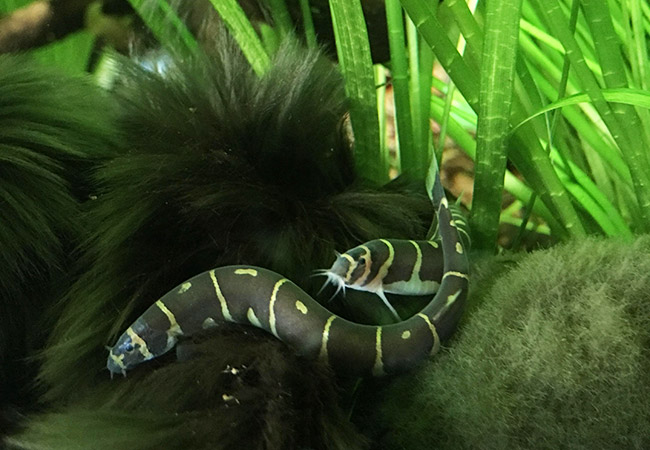
The result is a lovely centerpiece that his fish love to hide in.
As you see, if you know what you are doing, black beard algae isn't always bad news!
What is the cause of black beard algae?
One day it isn't there, then the next day it is. It feels like black beard algae magically appears on its own, right?
Well, it may surprise you to learn that black beard algae needs a little help from you.
Like most plants, algae requires certain conditions to thrive. If these conditions are met, black beard algae spreads across your tank like wildfire. Well, underwater wildfire anyway.
There are two common causes of black beard algae…
1. CO2 fluctuations
It is generally accepted that CO2 fluctuations are the number one cause of black beard algae.
If your CO2 levels are too low, your CO2 is fluctuating or you have poor water circulation, you are creating an environment that is perfect for black beard algae to grow.
If you have black beard algae, getting your CO2 levels in order should be your first priority. It could be your CO2 canister is running low, there is a blockage or you are not injecting the correct amount.
Don't run a CO2-injected tank? Your unstable CO2 levels could be a result of water changes – a large water change can significantly fluctuate the CO2 levels in your tank.
If this is the case, and you have a planted tank, I highly recommend dosing with Seachem Flourish Excel. It is a simple additive that provides your plants with a source of carbon, and, as I will discuss later, can be used to effectively kill black beard algae.
2. Too much light
Like many algae, black beard algae loves light. The more light it has, the faster it spreads. This is a particular problem for those of you with planted tanks – that LED grow light isn't just helping your plants to grow but algae too.
If you leave your aquarium light on for long periods of time (or never turn it off), then you are basically encouraging algae to enter your aquarium.
Reducing the amount of time that light shines on your aquarium can slow or even stop black beard algae from appearing altogether.
I recommend using a reliable aquarium timer to automatically turn your LED lights on and off each day. It's easier than manually doing it– something you will certainly forget to do.
Check out our detailed guide on aquarium timers for more information, including which timer is best for your aquarium.
Do you also have trouble with blue-green algae? Check out how to deal with it.
How do you remove black beard algae?
Important: To treat black beard algae, never scrub or pick at it. Your effort of removing black beard algae by scrubbing it can cause small pieces to float and settle on other plants or decorations in your aquarium, causing it to spread faster than before.
Your black algae problem typically won't go away on its own. Not without fixing the cause first – and even then, established algae in your tank will probably require a little effort on your part to banish it for good.
Use the tricks below to treat black beard algae in your aquarium.
So, you want to make your black algae problem go away for good?
1. Cut, cut, cut
This solution will only work if black beard algae has just begun to appear in small numbers on your plants. If black beard algae has already taken over your tank, skip to the next step.
If you see the dreaded black fuzz growing on the edge of your plant leaves, simply cut the entire leaf off at the stem and remove it from your aquarium.
However, a haircut alone will not save your tank – there are very likely other small pieces of black beard algae lurking in your tank, just waiting to make an appearance.
So, the next step is to treat the water with…
2. Liquid carbon
Or more specifically, Seachem Flourish Excel…
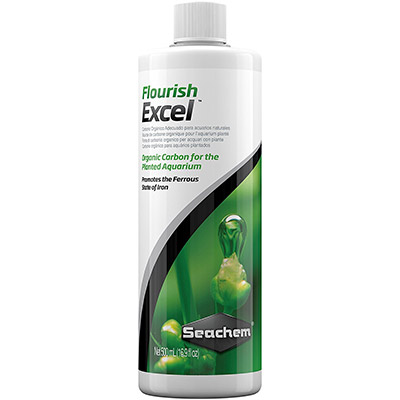
If removing black beard algae is not an option or too difficult now, this stuff is simply amazing! Not only does black beard algae hate it, but it will improve the growth of the other plants in your aquarium. This will be especially noticeable if you don't already inject CO2.
Using it is simple. Just follow the instructions. In my last tank, it took just a few days before I began to notice the black beard algae wither and die.
Ensure that your water flow is adequate to deliver the Excel to every corner of your tank.
If you don't notice a change, double dosing may be required. Alternatively, you can try spot dosing. This involves using a pipette or syringe to apply Seachem Excel directly to the algae.
Below is a quick video on just how effective spot treatment with Excel is!
If you take this route, ask an expert about the amount of Excel you should use for each dose – the amount will vary according to the size of your tank and the number of fish that is stocked.
Black beard algae often turns a red/pink as it starts to die before finally turning a clear, white color as it dies.
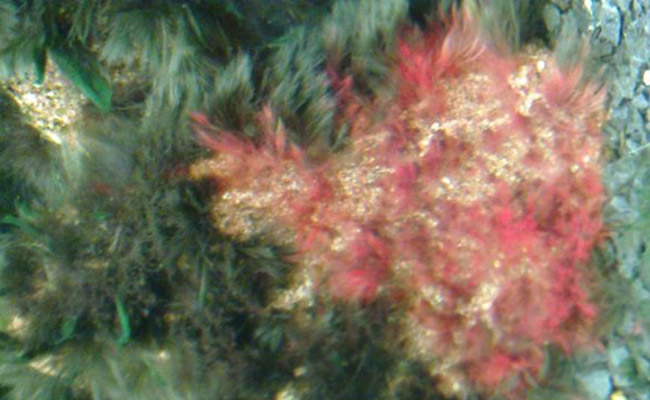
This dramatic color change is actually very helpful because it's obvious which areas you need to treat next!
Black beard algae eaters
Wouldn't it be great if you could just add a fish to your aquarium and have it take care of your black beard algae problem for you?
Well, there is!
The true Siamese algae eater.
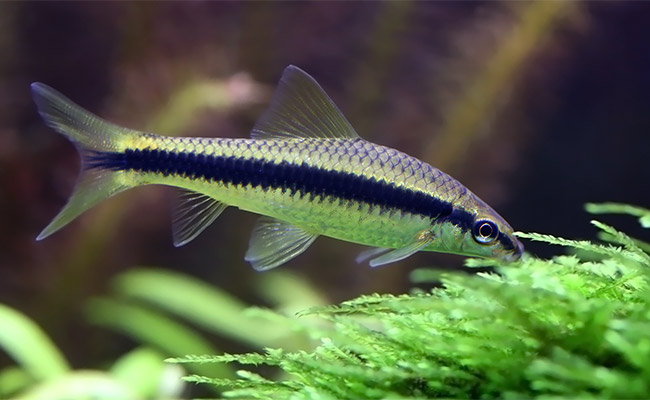
Black beard algae is just one of the many different algae that this Siamese algae eater fish eats.
Well… Should eat.
You see, there is no guarantee that this fish will eat the black beard algae in your tank. Like humans, fish have preferences to the type of food they eat, even among the same species.
And even if your Siamese algae eater does have a taste for black beard algae, it might not be able to nibble the algae fast enough to completely remove it from your aquarium.
This is also a common problem with shrimp as with Siamese algae eater. While they do eat black beard algae, they cannot eat it fast enough to make a noticeable difference.
Check out the video below. Despite the shrimp constantly chomping at black beard algae, they can't keep it in check.
If you want to stick to a proven method that works, and you don't want an extra mouth to feed!, I recommend using the Seachem Flourish Excel dosing method.
Conclusion
While it may not be harmful to fish, unwanted black beard algae can soon cover every corner of your tank – and to many, it looks darn ugly.
However, by maintaining proper tank parameters, and careful attempts on removing black beard algae, you should be able to prevent black beard algae from appearing in the first place.
How did you get rid of black beard algae in your aquarium? Let me know in the comments below!
How to Get Rid of Black Hair Algae
Source: https://fishlab.com/black-beard-algae/